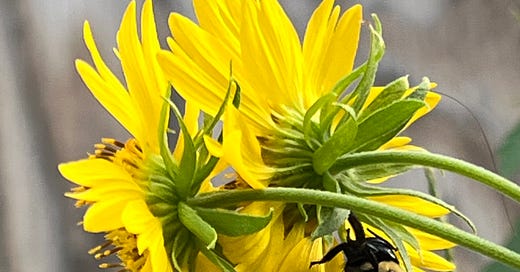In a previous post, I talked about the virtues of noticing amazing things nearby along our daily paths (see TDH #27). Here is more. Check out this photo I took:
Can you guess what this bumblebee is doing? If you saw it live, you’d see it’s perfectly still. Plus, notice that it’s on the back side of the flowers. It’s sleeping! Yes, I did a little research, and bumblebees do sleep, often on or inside flowers.
One common spot where bumblebees seek rest is in the comfort of flowers. Yes, you heard that right! Bumblebees often choose to sleep inside flowers, particularly those with trumpet-shaped petals or long tubular structures. These flowers provide a cozy and protective environment, shielding them from predators and adverse weather conditions.
In addition to flowers, bumblebees also seek out sheltered spots such as tall grass, dense vegetation, or even underground burrows. These locations offer them a sense of security and protection, minimizing the risk of predation during their vulnerable sleep periods.
While bumblebees are adaptable sleepers, they have a preference for sheltered locations. These sheltered spots provide them with additional protection from the elements and potential predators. Bumblebees have evolved to be highly sensitive to temperature fluctuations and adverse weather conditions, making shelter a crucial aspect of their sleeping habits. (article on pollenpaths.com)
On the bright Golden Crownbeard flowers, it’s often that I’ll see two or three Bumblers napping in the evening.
Lately there have been as many as 10-12, or so, buzzing from flower to flower during the day. Apparently, they pay as little attention to each other as they do to me watching them. I’ve seen three on one blossom, and I haven’t seen anyone chase anyone else off. Although one did pay particular attention to me the other day, which is rare. It had me flailing like a madman to scare it off and it persisted till I inadvertently bonked it and sent it reeling.
A Bumblebee Can't Fly?
You may have heard the popular thought that bumblebees defy physics and shouldn’t be able to fly. That idea came about in the 40’s and is no longer believed. Michael Dickinson, was interviewed, who is a professor of biology and insect flight expert at the University of Washington.
"The whole question of how these little wings generate enough force to keep the insect in the air is resolved," Dickinson said. "There are details remaining, but it's just not an enigma anymore." He says the big misconception about insect flight is the belief that bumblebees flap their wings up and down. "Actually, with rare exceptions, they flap their wings back and forth."
Take your arm and put it out to your side, parallel to the ground with your palm facing down. Now sweep your arm forward. When you reach in front of you, pull your thumb up, so that you flip your arm over and your palm is upwards. Now, with your palm up, sweep your arm back. When you reach behind you, flip your hand over again, palm down for the forward stroke. Repeat. If you gave your hand a slight tilt (so that it's not completely parallel to the ground), Dickinson said, you'd be doing something similar to a bug flap.
The fluid dynamics behind bumblebees' flight are different from those that allow a plane to fly. An airplane's wing forces air down, which in turn pushes the wing and the plane upward. For the bumblebee, the wing sweeping is a bit like a partial spin of a "somewhat crappy" helicopter propeller, Dickinson said, but the angle to the wing also creates vortices in the airlike small hurricanes. The eyes of those mini-hurricanes have lower pressure than the surrounding air, so, keeping those eddies of air above its wings helps the bee stay aloft. (from livescience.com)
Here’s a cool video that helps you see this wing sweeping motion:
As with most things, delving just a little deeper can help us appreciate something that’s often happening right under our noses. Or in our back yard.









Seriously, I never thought about bees sleeping! I love your Substack--you are never ever boring. And that photo is an awesome catch!